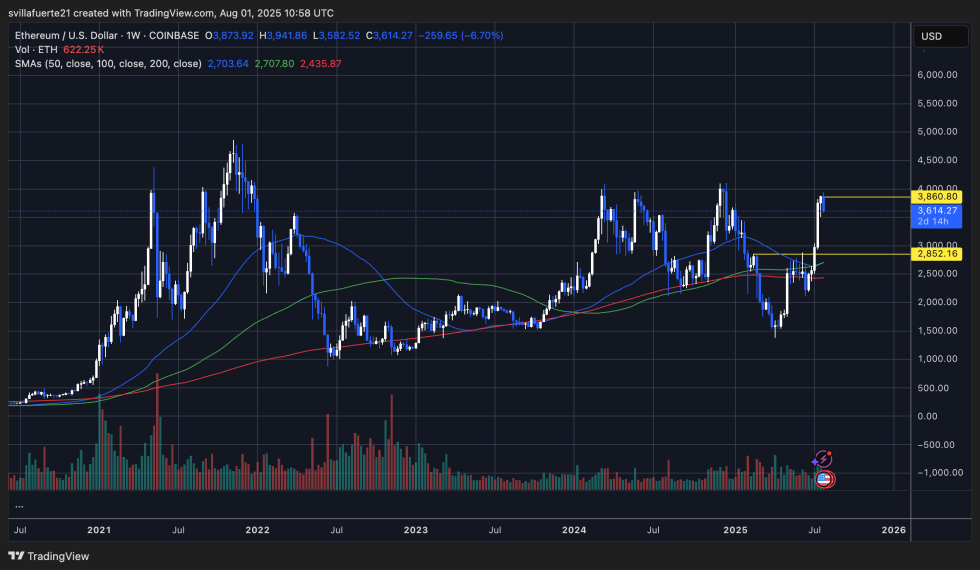Ethereum Crushes RWA Competition: 83.69% Market Dominance in 2025
Ethereum isn't just leading the RWA (Real World Assets) race—it's lapping the field. With an 83.69% stranglehold on the market, other chains are left scrambling for scraps. Here's how the smart contract pioneer became the undisputed heavyweight.
The DeFi Kingpin Flexes Its Muscles
While competitors tout 'disruption,' Ethereum's network effects and developer moat keep delivering real-world utility—not just vaporware roadmaps. Tokenized assets? Institutional pipelines? The chain that brought you NFTs and DeFi is now eating traditional finance's lunch.
Wall Street's 'Blockchain Consultants' Hate This One Trick
Funny how the same suits who dismissed crypto now begrudgingly build on ETH. Maybe because actual adoption—not PowerPoint slides—requires liquidity deeper than a hedge fund's excuses during a bear market. The numbers don't lie: when serious money moves on-chain, it's riding Ethereum's rails.
Ethereum Dominance in the RWA Market Strengthens Long-Term Growth
According to top analyst Ted Pillows, Ethereum currently holds an impressive 83.69% share of the total Real-World Asset (RWA) market capitalization by chain, highlighting its dominant position in one of crypto’s fastest-growing sectors. This commanding share has further solidified Ethereum’s role as the foundational layer for tokenized real-world assets, including stablecoins, government bonds, and private securities.

This trend began to accelerate notably in April 2025, coinciding with Ethereum’s sharp price surge and renewed investor confidence. The alignment of strong price action with on-chain expansion into tokenized finance reflects both speculative interest and long-term utility growth.
RWAs have become a focal point for institutional interest, with stablecoins leading the charge. Analysts view the stablecoin sector as the most likely on-ramp for real-world value into blockchain ecosystems over the next decade. Ethereum, which has long supported the largest stablecoin supply—including USDT and USDC—continues to lead the field, alongside Tron.
However, Ethereum’s advantage lies in its composability and DeFi integration, enabling more complex and scalable RWA infrastructures. As regulatory clarity improves and financial institutions MOVE toward on-chain issuance, Ethereum is positioned to capture even more market share.
If RWA tokenization becomes a multi-trillion-dollar industry as projected, Ethereum’s first-mover advantage and network effects may prove crucial. The data not only supports bullish long-term narratives—it suggests that Ethereum’s dominance in RWAs could be one of the key catalysts in the next major cycle.
Weekly Chart Shows Strong Breakout and Support Reclaim Amid Pullback
Ethereum’s weekly chart shows a powerful move above the $3,000 level, followed by a breakout toward $3,860 before facing resistance and a 6.7% correction down to $3,614. Despite the recent decline, the bigger picture remains structurally bullish. ETH reclaimed both the 100-week and 200-week moving averages ($2,707 and $2,435, respectively), which historically act as key trend-defining levels. Holding above these levels signals a potential long-term trend reversal from last year’s lows.

Volume surged during the breakout, suggesting strong demand rather than weak speculative buying. The $2,852 level now serves as the primary weekly support to watch—previously a multi-month resistance zone—which strengthens its significance. If ETH holds this support on the next retest, bulls could target another move toward $4,000.
A weekly close above $3,860 WOULD mark a new high for the year and open the path toward retesting the $4,500–$5,000 zone last seen in late 2021. However, failure to reclaim the $3,850 range quickly could lead to a larger pullback or sideways consolidation.
Featured image from Dall-E, chart from TradingView

